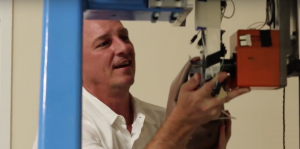
When the Cavaliers compete against Ohio University in Nashville on Saturday, Virginia’s players will be wearing groundbreaking, new head trauma sensory mouth guards as a part of a pilot program funded by the National Football League — and developed by engineers right here in Charlottesville and at the University of Virginia.
Engineering Prof. Richard Kent has not only taken on the NFL’s helmet standards throughout his career, but also oversees research at Charlottesville’s Biocore consulting lab. Biocore and the University of Virginia Center for Applied Biomechanics were selected by the NFL to pioneer new sensor technology that, if proven effective, will eventually be embedded in all players’ mouth guards to monitor any head trauma that they experience.
WUVA News previously interviewed Kent in June 2018. The professor of Mechanical & Aerospace Engineering, Biomedical Engineering, and Emergency Medicine at the University made it clear that when it comes to reducing concussions and head trauma at the college level all the way up to the NFL, the work to address the changing nature of the game begins in Charlottesville, and is becoming increasingly urgent.
“There’s a lot of effort into taking the head out of the game,” Kent told WUVA. “The proportion of concussions — not necessarily the raw number, but the proportion — that are caused by the head hitting the ground, it’s becoming more and more important.”
Kent and his colleague at Biocore, fellow U.Va. Engineering Prof. Jeff Crandall, who also serves as the University’s Director of the Center for Applied Biomechanics, have prioritized crafting tools that are minimally invasive to the player in terms of size and fit, but provide researchers with the most information about injuries on the field — and, ultimately, how to prevent them from happening in the first place.
“We’ve been focusing heavily on the technology,” Crandall told SportTechie. “What we’ve done is invested into a new technology that has very high accuracy, very small, fits into a package into a mouth guard. It’s much smaller than what was available on the market. It’s a completely new line of sensor technology…and [will] really help us convert that information into a helmet that’s really tuned at a position-specific level.”
The sort of position-specific helmets that Crandall describes, if successful, will protect against collisions that are most common in football — typically occurring during passing plays that result in a sack. This planned innovation, in its preliminary stages at the University of Virginia, could pertain the most to cornerbacks and wide receivers, who are at some of the highest levels of risk for head injury in their positions on the field.
The information provided by the Cavaliers’ new mouth guards will empower researchers to analyze more sophisticated data, and develop better helmets as a result.
“A lot of the design evolution of helmets has been, I guess I would call it, ad hoc,” Kent explained in an interview with SportTechie. “Try something and see how it works, and it’s not very systematic. What you end up getting is very complex geometries and complex materials, like foams that are interacting with plastics.”
Whether the Cavaliers win this Saturday or not, they will nonetheless be taking part in an innovation that has taken the best researchers in the country years to see to fruition. The head-trauma-sensory mouth guards that Virginia players will wear could lead to improved protection against concussions while they’re on the field — and, with their health in check, better game play in the long term.
















